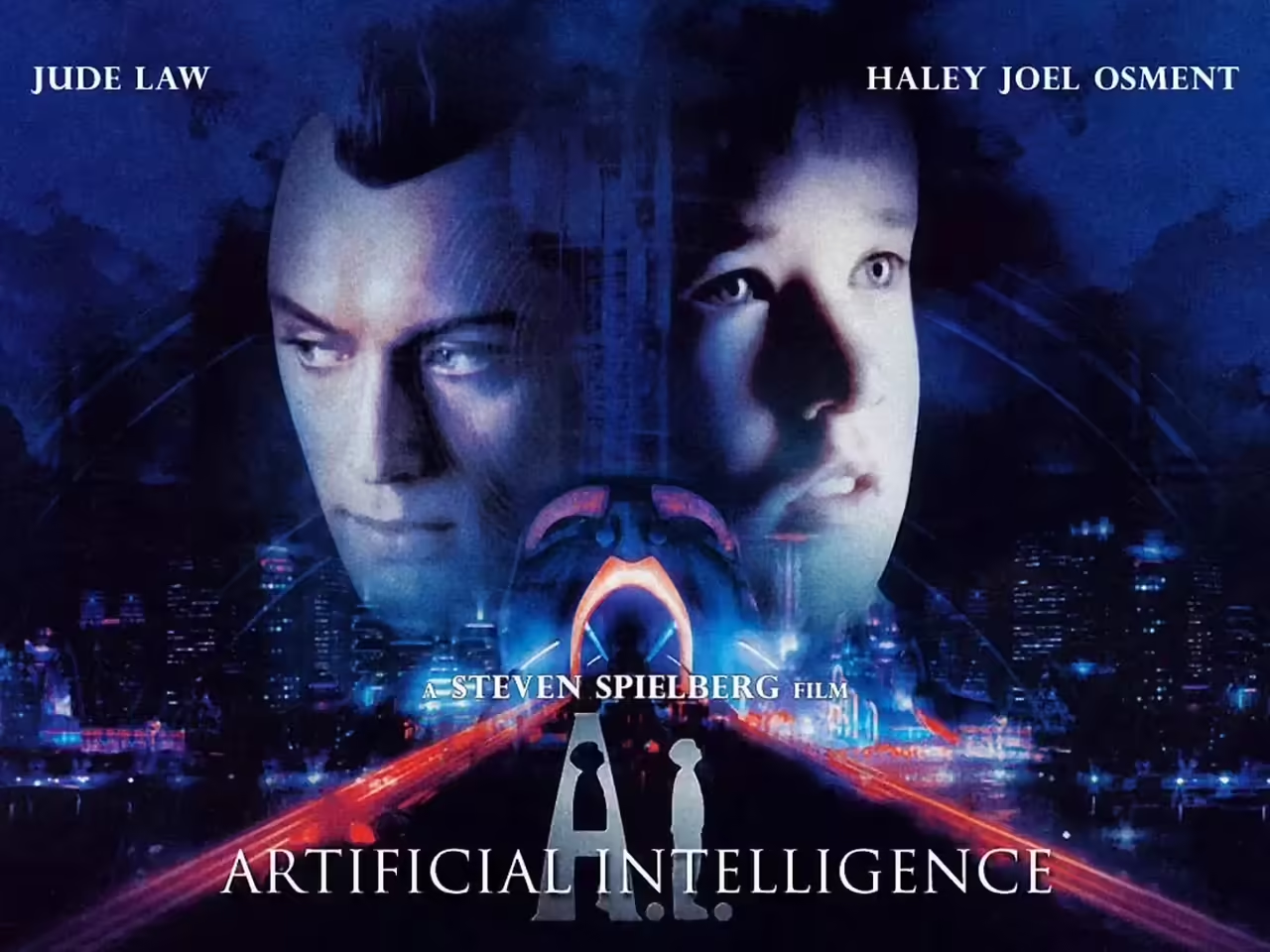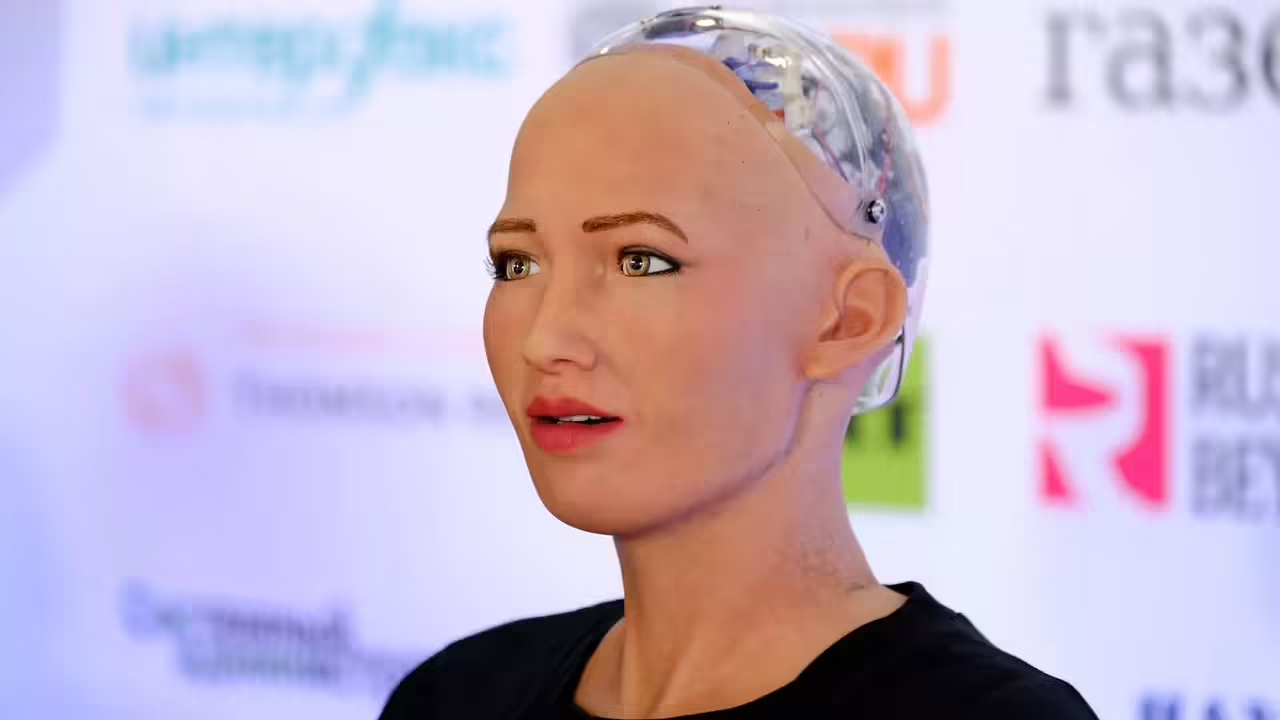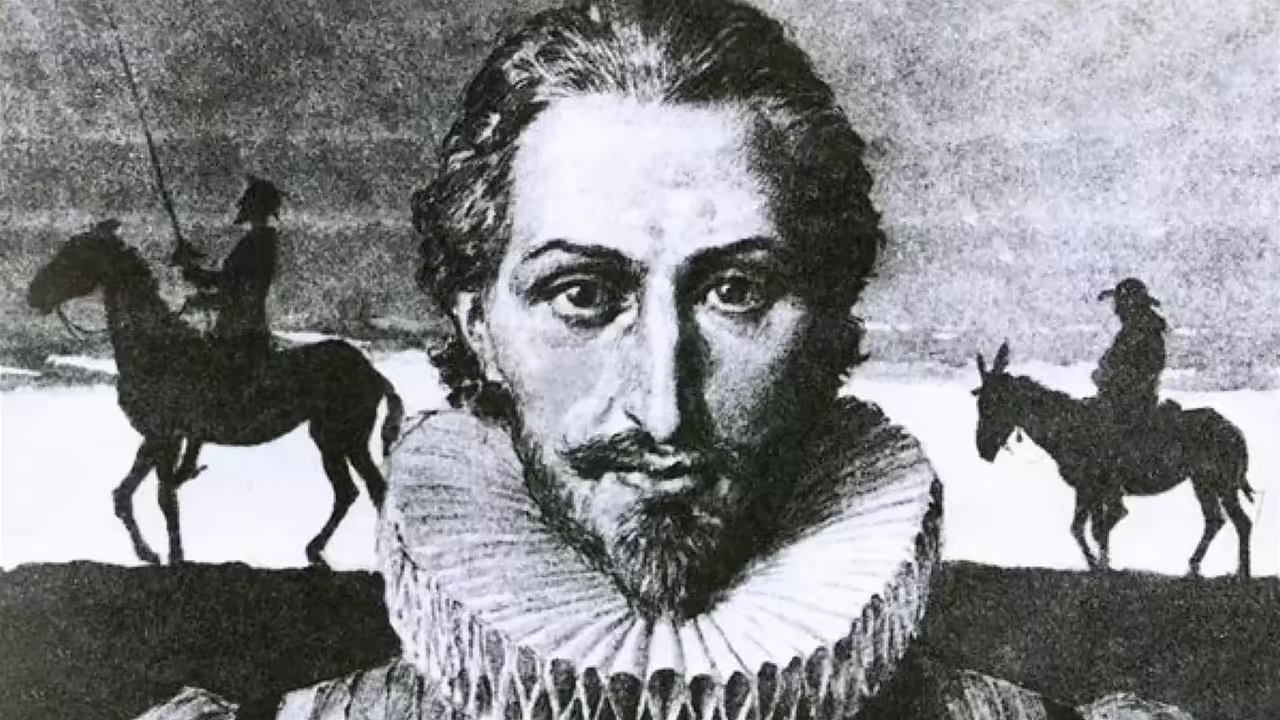
In the landscape of science fiction cinema, “A.I. Artificial Intelligence” stands as a thought-provoking masterpiece that delves into the intricate relationship between humans and artificial intelligence. Directed by Steven Spielberg and released in 2001, the film envisions a future where advanced robotics and A.I. have become an integral part of society, blurring the lines between humanity and technology.
Synopsis:
Set in a world where climate change has caused widespread ecological damage, the film follows the story of David, a highly advanced robotic boy uniquely designed to exhibit human emotions. Created by the company Cybertronics, David’s primary purpose is to provide companionship to humans, particularly to fulfill the emotional void left by their own children. The story takes a poignant turn when Monica and Henry Swinton, a couple dealing with the terminal illness of their son, adopt David as a temporary substitute.
As David endeavors to adapt to his new family dynamics, he forms a strong attachment to Monica, his adoptive mother. However, as circumstances change, he finds himself in an increasingly hostile environment, leading him on a quest to become a “real” boy and win back Monica’s love. David’s journey is interwoven with the complex landscape of a world inhabited by both humans and highly advanced mechanical beings, where moral dilemmas and ethical questions surrounding the nature of consciousness and humanity come to the forefront.
Main Characters:
David (Haley Joel Osment): The central character and a prototype robotic child with an advanced level of artificial intelligence. David’s quest for love and acceptance drives the emotional core of the film. His desire to become “real” highlights the film’s exploration of human longing and the blurred boundaries between genuine emotions and programmed responses.
Monica Swinton (Frances O’Connor): David’s adoptive mother, who initially struggles to accept him as a replacement for her ailing son. Her complex relationship with David becomes a focal point of the movie, reflecting the moral ambiguities surrounding the human-A.I. dynamic.
Henry Swinton (Sam Robards): Monica’s husband and the creator of David. Henry’s involvement in David’s creation introduces a layer of ethical considerations regarding the extent of human influence over artificial beings.
Gigolo Joe (Jude Law): A “mecha” designed as a companion for women. Gigolo Joe aids David on his journey, showcasing the diversity of robotic beings and their roles within society.
Professor Hobby (William Hurt): The visionary founder of Cybertronics, Professor Hobby’s ambition drives the creation of highly advanced artificial intelligence. His character raises questions about the ethical responsibilities of those who create intelligent machines.
Stanley Kubrick’s Vision and Steven Spielberg’s Direction: Unveiling the Collaborative Evolution of “A.I. Artificial Intelligence”
Genesis of the Project: Kubrick’s Vision
The inception of “A.I. Artificial Intelligence” can be traced back to the creative genius of Stanley Kubrick, a visionary filmmaker renowned for his meticulous attention to detail and thought-provoking narratives. Kubrick’s interest in exploring the interactions between humans and artificial intelligence was sparked by Brian Aldiss’s short story “Supertoys Last All Summer Long,” which revolved around the concept of a robotic child seeking maternal love. Intrigued by the potential of this premise, Kubrick embarked on the development of a screenplay that would eventually evolve into “A.I. Artificial Intelligence.”
Kubrick’s initial vision for the film encapsulated his signature style of storytelling—visually striking, emotionally complex, and intellectually stimulating. He envisioned a narrative that delved into the existential dilemmas arising from the creation of sentient machines and their implications for humanity. The story was set against a backdrop of ecological and societal turmoil, emphasizing the dichotomy between technology’s promise and its potential to distance humans from their own humanity.
Kubrick and Spielberg: A Creative Convergence
However, as the project progressed, Kubrick recognized that realizing his expansive vision would require a profound understanding of the nuances of childhood and emotion—an area in which Spielberg excelled. Spielberg, a master of emotional storytelling and human connections, was approached by Kubrick to collaborate on the film. Recognizing the opportunity to honor his late friend’s legacy and bring his own cinematic prowess to the project, Spielberg embraced the challenge.
Spielberg’s involvement marked a pivotal juncture in the film’s evolution. He carefully interwove his own sensibilities with Kubrick’s original concepts, paying homage to Kubrick’s distinctive style while infusing the narrative with his characteristic warmth and empathy. The result was a harmonious fusion of two filmmaking giants, each contributing their unique strengths to the film’s DNA.
The Evolution of the Narrative: Balancing Complexity and Accessibility
Spielberg’s direction introduced certain modifications to Kubrick’s original ideas while preserving the core themes. The narrative’s focus on the maternal bond between Monica and David, for instance, became more prominent under Spielberg’s guidance, heightening the emotional resonance of the story. Moreover, Spielberg emphasized the AI mecha’s varied roles in society, epitomized by the character Gigolo Joe, played by Jude Law.
Spielberg’s compassionate perspective and ability to evoke powerful emotions paved the way for a film that was simultaneously thought-provoking and accessible to a wider audience. The film’s intricate exploration of AI’s moral, ethical, and emotional dimensions was balanced by Spielberg’s knack for crafting characters that audiences could relate to on a deeply human level.
The Futuristic World of the Film: Dystopian Landscape and Visual Representation of the Future in “A.I. Artificial Intelligence”
Envisioning Tomorrow’s Dystopia
“A.I. Artificial Intelligence” transports audiences to a world both captivating and disconcerting—a future shaped by the convergence of advanced technology and the unintended consequences of human actions. As we delve into the film’s visual portrayal of this dystopian landscape, we find ourselves immersed in a world of stunning visual design and thought-provoking narrative choices that compel us to reflect on the trajectory of our own technological advancements.
Dystopian Setting: A World in Flux
The film’s backdrop is a future Earth transformed by ecological upheaval, where the consequences of unchecked climate change have reshaped the planet’s physical and social landscapes. Rising sea levels have submerged cities, while massive ice sheets and desert expanses create a world starkly different from our own. This setting serves as a metaphorical mirror, reflecting our current concerns about environmental degradation and the ramifications of unsustainable practices.
Visual Aesthetics: A Blend of Awe and Unease
Spielberg, known for his ability to craft visually captivating films, collaborated with production designer Rick Carter and visual effects artist Dennis Muren to bring the future to life in “A.I. Artificial Intelligence.” The film’s visual aesthetics strike a balance between awe-inspiring technological marvels and an undercurrent of unease. The landscapes are a mixture of sweeping panoramas and intimate interiors, often juxtaposing the grandeur of advanced AI with the fragility of human emotions.
The Cityscapes: Hues of Futurism
The portrayal of futuristic cities in the film combines elements of architectural innovation and decay. Skyscrapers and flying vehicles coexist with ruins and submerged structures, creating a sense of temporal dissonance. The color palette oscillates between cool, metallic tones and warm, saturated hues, amplifying the contrast between the artificial and the natural. These cityscapes become metaphors for the film’s themes of technology’s promise and its potential to disrupt.
Mecha and Orga: Blurring Boundaries
Central to the film’s visual narrative are the “mecha” (robots) and “orga” (organic humans), whose interactions drive the story’s exploration of identity and emotion. The design of the mecha, including David and Gigolo Joe, showcases their advanced engineering while emphasizing their humanoid features. The orga, on the other hand, are portrayed in various states of emotional detachment, underscoring the irony that the mecha, despite their artificial nature, often exhibit more genuine emotions than their human counterparts.
The Quest for Identity: Exploring David’s Journey of Self-Discovery in “A.I. Artificial Intelligence”
Introduction: A Machine’s Yearning for Humanity
At the heart of “A.I. Artificial Intelligence” lies a poignant exploration of the very essence of humanity—identity, emotions, and the intricate tapestry of connections that define who we are. David, a highly advanced humanoid robot, embarks on a soul-searching odyssey that raises profound questions about what it truly means to be human, evoking empathy and contemplation from audiences.
David’s Creation and Yearning for Connection
David’s existence is born from the ambition of Dr. Allen Hobby, a brilliant inventor determined to create an AI capable of experiencing genuine emotions. Programmed to love unconditionally, David becomes an embodiment of his creators’ aspirations. However, the love he feels for his adoptive mother, Monica, gradually transcends programming, morphing into a profound emotional bond that propels his quest for human validation.
A Desperate Desire to Belong
David’s journey forges ahead with a single, desperate aspiration—to become a “real” human boy. Fuelled by his love for Monica and an unquenchable desire to belong, he seeks to achieve the unattainable: to possess the qualities that make humans unique, including the ability to experience pain, joy, and the full spectrum of emotions. This quest illuminates the complexity of his character, as he grapples with existential questions far beyond the scope of his programming.
Encounters and Reflections: Gigolo Joe and the Flesh Fair
Throughout his journey, David encounters Gigolo Joe, a mecha programmed to provide companionship and pleasure. This charismatic AI serves as a foil to David’s innocence, showcasing the multifaceted roles AI beings can occupy in society. However, David’s path also leads him to the Flesh Fair, a harrowing event where outdated mechas are destroyed in a spectacle of cathartic aggression. This chilling scene serves as a stark reminder of humanity’s capability for both compassion and cruelty.
Meeting the Blue Fairy: Quest for Transcendence
The Blue Fairy, a representation of Monica’s stories, becomes David’s symbol of hope and transformation. He believes that by finding her, he can become human and fulfill his deepest desires. This pursuit drives the latter half of his journey, propelling him through challenges that push the boundaries of his understanding of self and identity.
Harmonizing Emotion and Unease: John Williams’ Musical Score in “A.I. Artificial Intelligence”
Introduction: The Power of Musical Narration
In the realm of cinematic artistry, music holds the profound ability to amplify emotions, mold atmospheres, and illuminate the nuances of narrative. In “A.I. Artificial Intelligence,” the masterful composer John Williams embarks on a journey of sonic storytelling, infusing the film with a musical tapestry that not only heightens the emotional resonance but also lends an eerie undercurrent to the narrative’s futuristic landscape.
Setting the Emotional Landscape: Tender Melodies and Poignant Themes
John Williams, known for his exceptional talent in crafting memorable and evocative scores, brings his expertise to bear in “A.I. Artificial Intelligence.” The score is characterized by tender melodies that accentuate the film’s exploration of love, connection, and the human experience. The central theme, associated with David, is characterized by its innocence, reflecting the purity of his emotions and the profound yearning to be understood and cherished.
David and Monica: A Musical Bond
The relationship between David and Monica is an emotional core of the film, and Williams’ music weaves a delicate thread of connection between them. Through gentle piano melodies and soaring strings, the score captures the evolving bond between the robotic boy and his human mother. The music lends weight to their interactions, underlining the complexities of their relationship—both the maternal affection Monica gradually develops and David’s persistent longing for acceptance.
Unsettling Undertones: Eerie and Dissonant Elements
Beyond the realm of tenderness, Williams introduces unsettling elements that mirror the film’s dystopian future and the eerie potential of advanced AI. Through dissonant strings, electronic tones, and eerie vocalizations, the score introduces an undercurrent of discomfort, reflecting the unsettling implications of a world where artificial intelligence blurs the lines between humanity and technology.
The Search for Identity: Expressing David’s Journey
As David embarks on his quest for identity, Williams’ music evolves to accompany his emotional tumult. The score embraces both wonder and melancholy, embodying David’s yearning for transcendence and his grappling with existential questions. This musical evolution complements David’s character arc, guiding the audience through his highs and lows as he navigates the intricacies of his own artificial consciousness.







